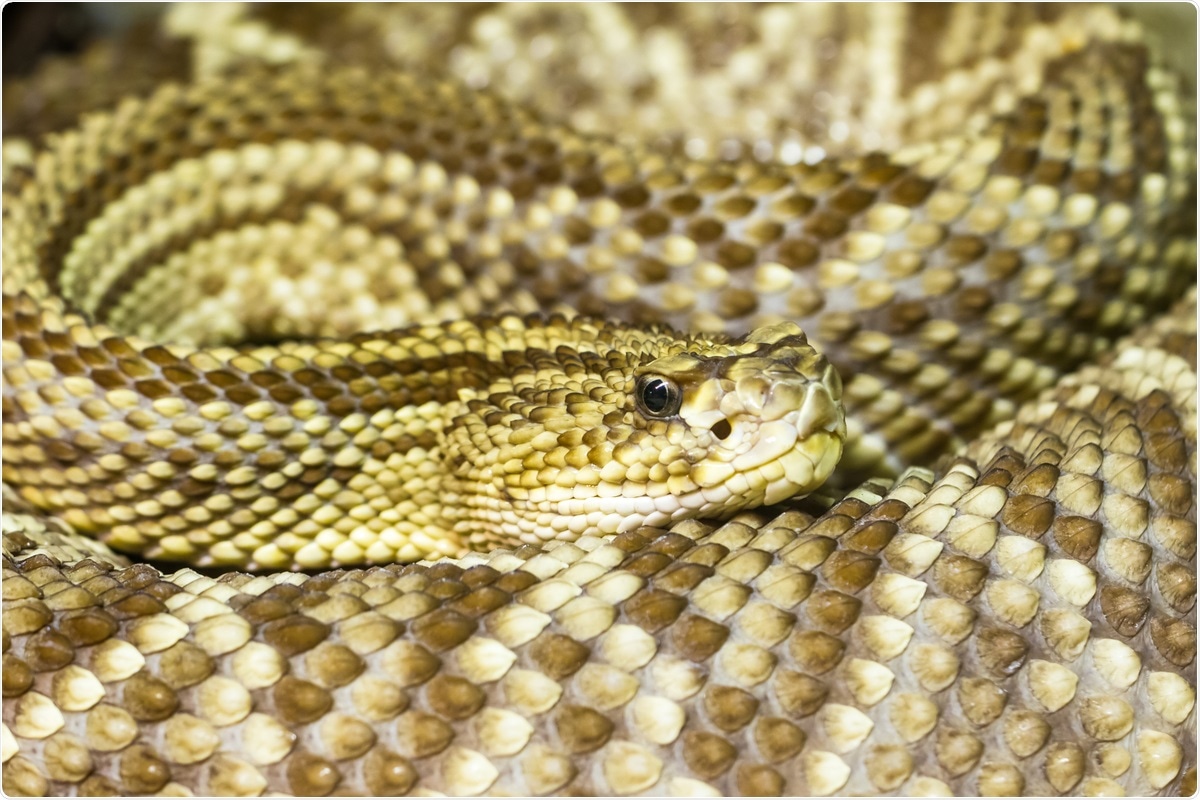As the coronavirus disease 2019 (COVID-19) pandemic continues to infect people worldwide, specific pharmaceutical interventions have been found to be few. As the logistics of mass vaccination are still being ironed out, most public health measures across the globe still largely involve non-pharmaceutical interventions (NPIs) such as physical distancing, hand and face hygiene, mask-wearing, isolation of infected people and tracing of contacts.
Now, an interesting new study appearing on the bioRxiv* preprint server reports the virucidal and fusion-inhibiting attributes of snake venom against the COVID-19 agent, the severe acute respiratory syndrome coronavirus 2 (SARS-CoV-2).

Snake venom as a source of virucidal compounds
Snake venom has been reported to contain compounds with multiple physiological activities, including antibacterial, antifungal, antiparasitic and antiviral properties. The current study explores one component of snake venom, the secreted phospholipase A2 enzymes (sPLA2s), which have a wide range of diverse sequences and biological functions. These are primarily involved in lipid metabolism and signaling pathways.
Variation in PLA2 activity
PLA2s are small secreted protein enzymes that facilitate the hydrolysis of membrane glycerophospholipids to lysophospholipids and free fatty acids. For instance, some of these enzymes may break down the envelope lipid bilayers by hydrolyzing the phospholipids. Others may be unable to do so.
An earlier study on dimeric PLA2 crotoxin, from Crotalus durissus terrificus, and its active subunit PLA2-CB, were able to inactivate dengue virus type 2, among other viruses, by splitting the glycerophospholipids of the virus envelope. However, these toxins did not affect Coxsackie B5 and encephalomyocarditis virus, which lack a lipid envelope. They were also inactive against viruses that bud through the plasma membrane.
The virus envelope can have varying composition, depending on the origin of the lipids – from the plasma membrane or the endoplasmic reticulum membrane. This can affect the activity of the PLA2, suggesting that the phospholipid breakdown caused by these enzymes mediates their antiviral effects.
Dimeric PLA2 suppresses viral replication
The researchers found that sPLA2s act against SARS-CoV-2 in vitro, particularly group IIA dimeric PLA2s. When the virus was treated with the two dimeric PLA2s HDP-1 and HDP-2, strong virucidal activity was observed to result. This was observed as suppression of the cytopathic effect (CPE) expected as a result of viral infection of cell cultures.
Such inhibition was observed even at low concentrations (0.1 μg/ml). The active subunit of HDP-2 (HDP-2P) is twice as active as the whole enzyme. This was inhibited by the presence of the PLA2 inhibitor, 4-bromophenacyl bromide, which acts by modifying the active center His residue.
An earlier study of cobra group IA PLA2 CM-II showed no virucidal properties when tested against the related pathogen, Middle East respiratory syndrome coronavirus (MERS-CoV). This may be explained by the genetic and structural differences between this virus and SARS-CoV-2, such as the 70% divergence in their spike (S) glycoproteins. If this is the case, different groups of PLA2s can affect the virus in a varying manner.
Inhibition of cell fusion
The researchers also found that at concentrations varying between 1 to 100 μg/ml, both dimeric HDP-1 and HDP-2 inhibited spike-mediated syncytia formation, thus hindering the virus's spread between cells. While there was about 70% inhibition at 100 μg/ml, it was reduced to about 48% at 1 μg/ml. Notably, the active subunit HDP-2P completely blocked the cell-cell fusion at 100 μg/ml. This could indicate that they can prevent viral entry into cells, one more possible mechanism by which they prevent viral infection of host cells.
The hydrolysis of membrane phosphatidylcholine by PLA2 generates lysophosphatidylcholine, a known inhibitor of the membrane fusion caused by viruses like influenza, rabies and simian influenza viruses. This activity can prevent the entry of the virus into the host cells.
Weak effect on cell viability
The study also showed a weak effect on cell viability, as shown by reduced cell proliferation. The anti-proliferative and cytotoxic effect of PLA2s reported in earlier studies is directed against cancer cells, mainly, and not normal cells. Moreover, the PLA2s studied here were used at very low concentrations, orders of magnitude lower than that required to produce an effect on normal cells. This lends value to the concept of using these enzymes to produce antivirals, as well as to study how viruses interact with host cell membranes.
The researchers also found some degree of similarity between the S protein of SARS-CoV-2 and the dimeric PLA2s, especially the spike segment that interacts with the host cell ACE2 receptor. This may indicate that dimeric PLA2s competitively inhibit viral binding to ACE2. More research will be required to elucidate the real mechanism by which the PLA2s block syncytia formation mediated by the spike glycoprotein.
Conclusion
Summarizing previous and our findings on the ability of snake PLA2s to inactivate various viruses, these results highlight the potential of PLA2s as a natural product for the development of broad-spectrum antiviral drugs."
Not only so, these drugs, which act specifically on the lipid bilayer of the viral envelope, offer an excellent method to understand how viruses attack the host cell membranes, from which their lipids are derived.
*Important Notice
bioRxiv publishes preliminary scientific reports that are not peer-reviewed and, therefore, should not be regarded as conclusive, guide clinical practice/health-related behavior, or treated as established information.
https://news.google.com/__i/rss/rd/articles/CBMibGh0dHBzOi8vd3d3Lm5ld3MtbWVkaWNhbC5uZXQvbmV3cy8yMDIxMDExNC9BLXNuYWtlLXZlbm9tLWVuenltZS1zaG93cy1hbnRpLVNBUlMtQ29WLTItYWN0aXZpdHktaW4tdml0cm8uYXNweNIBcGh0dHBzOi8vd3d3Lm5ld3MtbWVkaWNhbC5uZXQvYW1wL25ld3MvMjAyMTAxMTQvQS1zbmFrZS12ZW5vbS1lbnp5bWUtc2hvd3MtYW50aS1TQVJTLUNvVi0yLWFjdGl2aXR5LWluLXZpdHJvLmFzcHg?oc=5
2021-01-14 17:23:00Z
CAIiEBNx-yqVdRkpHQYl09dt1KEqMwgEKioIACIQZdRflS9INK7zM5FkBi3R3CoUCAoiEGXUX5UvSDSu8zORZAYt0dwww8TIBg
Bagikan Berita Ini














0 Response to "A snake venom enzyme shows anti-SARS-CoV-2 activity in vitro - News-Medical.Net"
Post a Comment